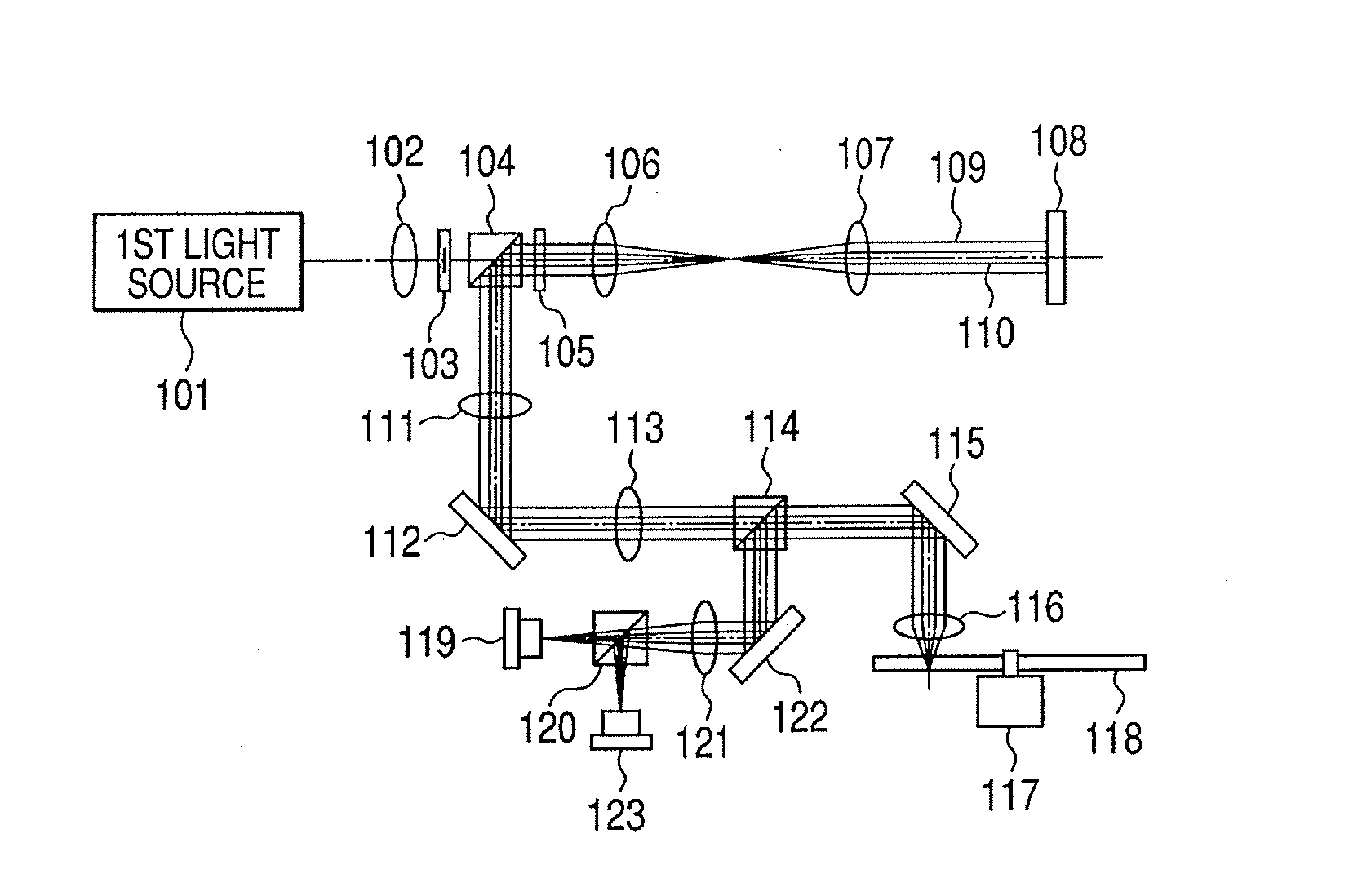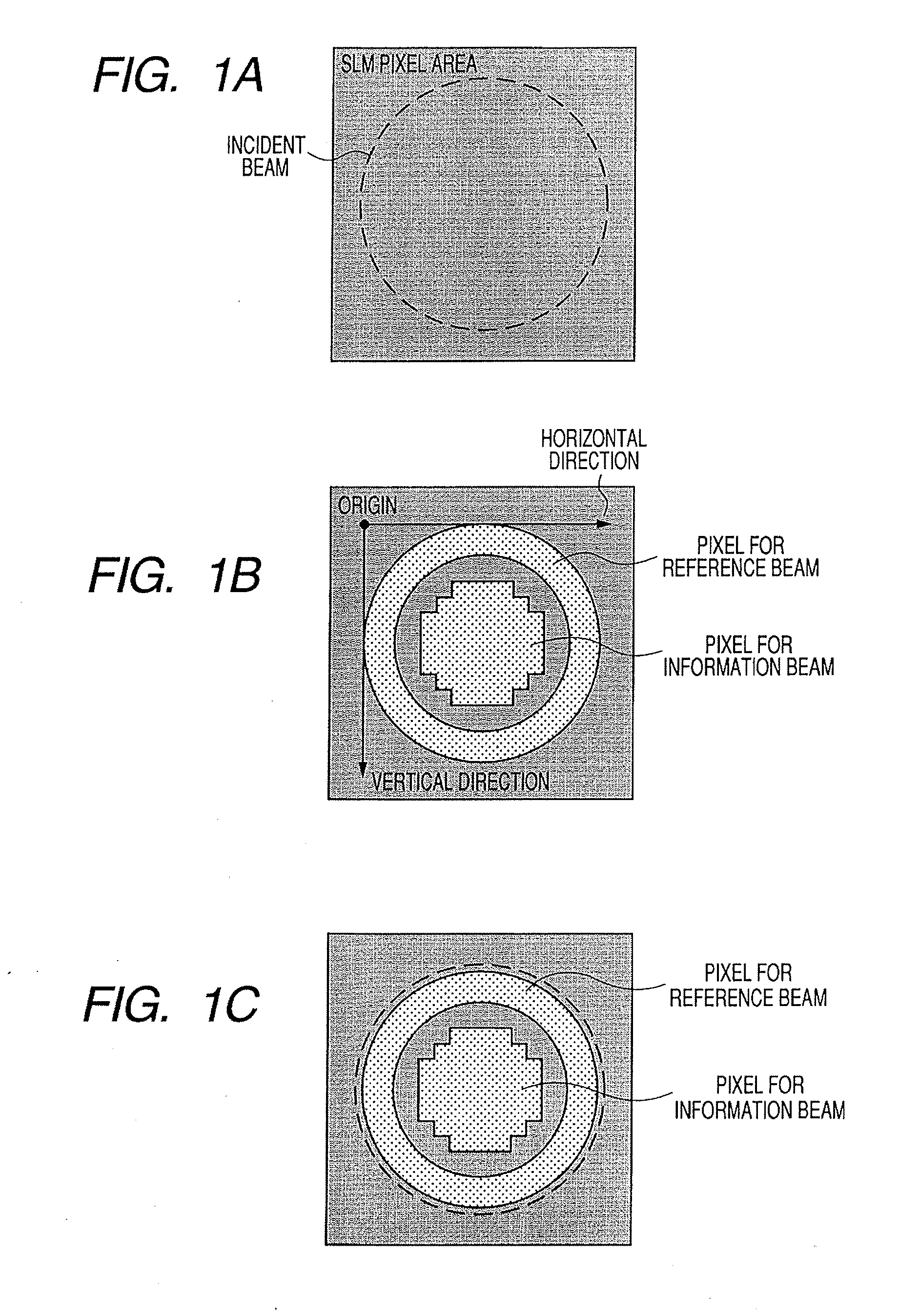Optical information recording and reproducing apparatus and optical information recording apparatus
- Summary
- Abstract
- Description
- Claims
- Application Information
AI Technical Summary
Benefits of technology
Problems solved by technology
Method used
Image
Examples
first embodiment
[0060] First, a concept of the correction of a positional shift in the present invention will be described. In a holographic memory system, due to various factors, the positional shift may be generated in the positional relationship between the light beam incident on a two-dimensional spatial light modulator (SLM) and a spatial light modulator. The present invention corrects this shift or attempts at its compensation. The correction of the positional shift will be described below by using FIGS. 1 to 3.
[0061]FIGS. 1A to 1C show a case where the positional relationship between an incident beam on a SLM and the SLM is according to a design. As shown in FIG. 1A, a two-dimensional SLM comprises a square effective pixel area, and inside this effective pixel area, there is arranged a large number of pixels in a matrix pattern. The incident beam is circular, and its diameter is smaller than the effective pixel area of the SLM. If the positional relationship is according to the design, the ...
second embodiment
[0129] In the present invention, as a correction method of the shift of an incident beam to a spatial light modulator, as described above, there is a method of physically moving the spatial light modulator itself according to the shift amount in addition to the method of changing a start position of the shift register and electrically correcting a display position at the spatial light modulator. FIG. 20 is a view explaining about a shift correction by physical movement.
[0130] In FIG. 20, in the surface of the spatial light modulator, an actual incident beam 303 is shifted from a designed incident beam 301. Directly below the spatial light modulator, a light sensing device area of a CMOS sensor is provided, and each light receiving pixel shall be shown by reference numeral 302. Further, a point that serves as a reference for the operations of a horizontal shift register and a vertical shift register is an origin 310. In the present embodiment, for such a shift, as shown in FIG. 20, ...
third embodiment
[0131] In the above described first embodiment, while the modulator / light sensing device 108 has been configured by laminating the spatial light modulator (SLM) and the light sensing device (CMOS sensor) on the surface of the silicon semiconductor substrate in a vertical direction, the modulator / light sensing device used in the present invention is not limited to this. In the modulator / light sensing device 108, the spatial light modulator and the light sensing device may be arranged in a horizontal posture for each pixel. FIG. 21 shows the modulator / light sensing device 108 in which the SLM and the light sensing device are arranged in such a horizontal posture.
[0132] The modulator / light sensing device 108 shown in FIG. 8 comprises a SLM element area 64 having the SLM composed of a reflection type light interference modulator and a CMOS sensor area 65 having a CMOS light sensing device for each pixel. The SLM element area 64 and the CMOS sensor area 65 for each pixel are provided in...
PUM
 Login to View More
Login to View More Abstract
Description
Claims
Application Information
 Login to View More
Login to View More - R&D
- Intellectual Property
- Life Sciences
- Materials
- Tech Scout
- Unparalleled Data Quality
- Higher Quality Content
- 60% Fewer Hallucinations
Browse by: Latest US Patents, China's latest patents, Technical Efficacy Thesaurus, Application Domain, Technology Topic, Popular Technical Reports.
© 2025 PatSnap. All rights reserved.Legal|Privacy policy|Modern Slavery Act Transparency Statement|Sitemap|About US| Contact US: help@patsnap.com



